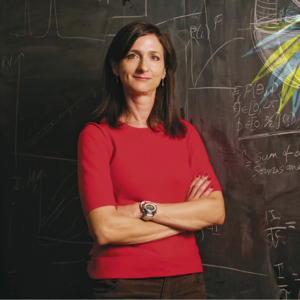
Sara Seager
Biography
Professor Sara Seager was born and grew up in Toronto, Canada. Among her first memories is a trip to a “star party” with her father, to see the moon through a telescope—spectacular! During high school she was astounded to learn that one could be an astrophysicist for a living, only to be deterred by her father, who believed the best career was as a doctor or lawyer.
Professor Seager entered the University of Toronto with the idealistic view that anything and everything could be described by a physics equation. She soon learned, that, in reality, approximations are not only rampant but necessary. This realization motivated Professor Seager to eventually leave pure physics to pursue her “first love” astronomy. After graduating with a BSc in the Math and Physics Specialist Program at the University of Toronto, Seager attended the PhD program in Astronomy at Harvard .
While at Harvard, in the mid-1990s, the first reports of exoplanets around sun-like stars began appearing. Encouraged by her PhD supervisor, Dimitar Sasselov, Seager studied the atmospheres of these so-called hot Jupiter planets. At the time, many scientists were skeptical of the new planets, preferring to believe they were the result of a different phenomenon, such as star variability. Others thought the claims made in Seager’s thesis would never be substantiated. But exoplanets kept turning up and Seager’s early work was eventually validated.
After earning a PhD from Harvard in 1999, Professor Seager joined the cadre of postdoctoral fellows at the Institute for Advanced Study in Princeton, NJ. There, she benefited enormously from the mentorship of the late John Bahcall. Unlike most scientists at the time, John Bahcall supported Seager’s new ideas in exoplanets with almost unbounded enthusiasm, as long as the underlying physics was sound and the phenomenon was detectable some day in Seager’s lifetime. Bahcall’s support enabled Seager to initiate several new topics in exoplanet characterization.
Professor Seager’s research now focuses on theoretical models of atmospheres and interiors of all kinds of exoplanets as well as novel space science missions. Her research has introduced many new ideas to the field of exoplanet characterization, including work that led to the first detection of an exoplanet atmosphere. She was part of a team that co-discovered the first detection of light emitted from an exoplanet and the first spectrum of an exoplanet. The exceedingly surprising diversity of exoplanets has led Seager’s maxim, “For exoplanets, anything is possible under the laws of physics and chemistry.”
Professor Seager is now an astrophysicist and planetary scientist at MIT. She lives with her husband and two sons in Massachusetts.
